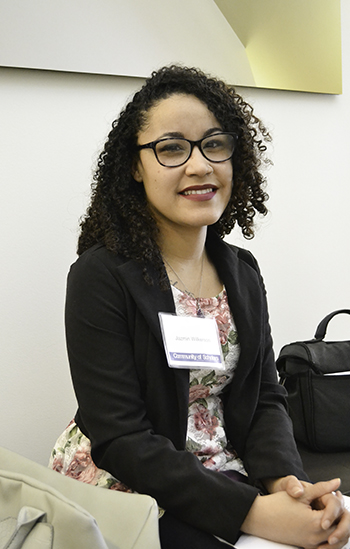 |
| Jasmin Wilkerson, a COS participant who will be attending graduate school at Illinois in Library Science. |
By Elizabeth Innes
Seeking to increase the number of underserved students who attend graduate school at Illinois, the Graduate College invited undergraduate minority students from around the country to experience Illinois during Community of Scholars (COS), its spring campus visit program on March 6–8. Like its name implies, the goal of COS is to show visitors that, should they come to graduate school here, they would be valued members of a much larger community of scholars and would have access to numerous resources.
According to Associate Dean Assata Zerai: “In the grad college, it’s very important to us to increase the number of students who are underrepresented in graduate education, and the Community of Scholars is about, of course, recruiting some of those students into our programs and letting them know the awesome resources that we have on our campus.”
Zerai stresses that an overarching goal for the 2-day event is that students would recognize that they are valued:
“I think it’s just really great for students to get a sense of the fact that we’re not just bringing them here to fill some kind of quota, but that they are truly welcomed and, further, that we have resources to support them while they’re here. So I think that makes a huge impact in terms of their decisions about if they’re going to come or not.”
One such resource introduced to the students during one COS session is the 12,000-entry Graduate College funding database available to Illinois students. “It’s an amazing resource,” says Zerai.
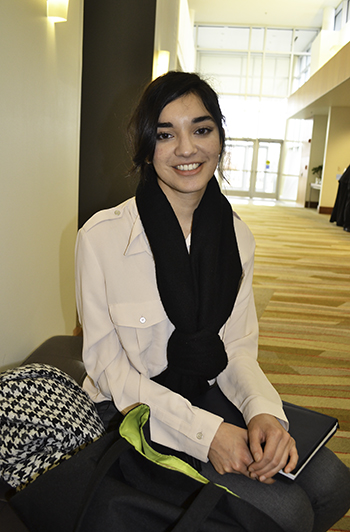 |
| Madeline Gonzalez, an undergrad at the University of Texas Pan-American |
Madeline Gonzalez
Another overarching goal of the weekend was to show the attendees that Illinois is the school for them. That’s why Madeline Gonzalez came. “I’m coming here to see—to help me decide,” she admits. Gonzalez, who graduated in May from the University of Texas Pan-American, has been accepted to Illinois’ Communication Sciences and Disorders Master’s Program in Speech Therapy.
What was Gonzalez’ favorite aspect of Community of Scholars? “I think what was most attractive was the fact that I would get to meet the department, that I would really get to see the school.”
Another incentive to attend that she found attractive? The Grad College footed the bill: “If I’m honest, it was also funded—the travelling and the stay. I more than likely would not have this opportunity had it not been for the Community of Scholars. I would’ve had to make my graduate decision based on the website.”
Since she’s thinking about going on for a Ph.D., Gonzalez also appreciated the exposure to the grad students and their research. “It was really interesting to see what other graduate students are doing. Part of what draws me to this university is the research, because the Master’s thesis is optional in my degree, but it’s something that I want to I pursue so that I can see if I would like to pursue a PhD. It’s been great to learn about fellowships or what PhD students are doing. I’m like, ‘Maybe I’ll be part of that world one day.’”
Dillinger James
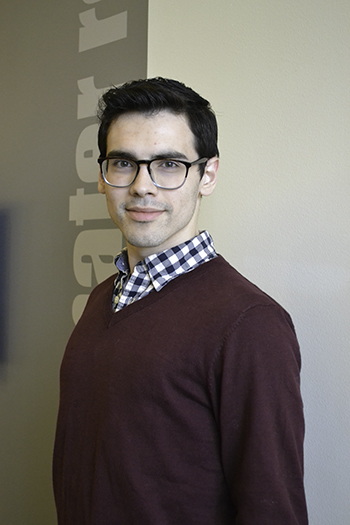 |
| Dillinger James, who will be a grad student this fall in Illinois' Industrial and Enterprise Systems Engineering Department |
Another undergrad attending COS was Dillinger James from the University of Washington. James has been admitted to Illinois’ Industrial and Enterprise Systems Engineering Department and has accepted the offer. COS was actually his 2nd visit to campus; his first visit through the MERGE (Multicultural Engineering Recruitment for Graduate Education) program sealed the deal. However, COS helped him make connections and find his niche in his department.
“This visit is also a better opportunity for me to actually meet with individual faculty members, talk more about research, different funding opportunities, and then just getting more familiar with the campus and the culture. So I’m very fortunate that they invited me, and I’m glad to be here.”
James hadn’t actually planned on grad school until he started getting letters from schools—including Illinois. “I’ve never heard about it, because I’m from Seattle,” he admits, “but once I researched the University of Illinois, I became very intrigued, and I was very impressed. Excellent engineering school, well credited, such a diverse population, very diverse research areas.”
Like Gonzalez, James is another student on whom the Illinois students made quite an impression.
“I’m somebody who needs to meet people face to face, I need to see things with my own eyes. So having this as my 2nd visit, it has been different. I’ve gotten to speak with undergraduate students, speak with graduate students from varying disciplines, hear about their research, their experience here. They’re not paid recruiters, they’re here to give me an open and honest opinion. It is quite staggering the overwhelming enthusiasm every student has had about being a student at Illinois.”
Jessennya Hernandez
Hernandez, an undergrad from Cal State, Pomona, says: "I would not have had the funds to come here to visit. Everybody who I’ve heard from who are graduate students said you have to visit the school before you make a decision. I wouldn’t have had the ability to do that if it wasn’t for this event...For me it’s just really looking and the school, and looking at the department will be what I’m most interested in, talking to them, getting a feel for what kind of community I would be living in and working with. That’s what’s most important to me.
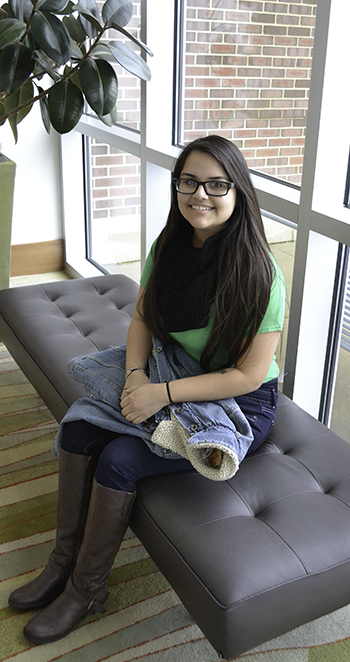 |
| Jessennya Hernandez, undergraduate student from California State, Pomona |
Like Zerai said, the thing that impressed Hernandez the most was that COS made her feel valued: "It lets me know that as a minority student, I’m important. There’s resources for me and outreach as well. Other schools didn’t give me that impression. They noted that I was a minority student but they didn’t go a step beyond that. I had to reach out to them and ask them 'As a minority student, what can be done for me?' This made it all happen without me realizing it. So that was a big thing. It’s impressive to me.
But COS isn’t just for visiting students. According to Associate Dean Zerai, it also benefits current Illinois students. “It’s about building community amongst students who are already here, and so we have our mini conference, and we had a group of presentations both yesterday and today…So this allows us to support our students that are already here and to show off the awesome work that they’re doing to the prospective students who are coming for their visit.”
For example, some Illinois students got to brush up on their presentation skills. “The students that are already here, I think, are benefitting from the opportunity to present their research to a friendly audience,” Zerai says. “I think they’re also benefitting, of course, in terms of another resume building opportunity. Also, I think the more opportunities they get to present their work, they’re better able to refine their ideas because they’re getting feedback from their peers, feedback from faculty and administrators that are attending the mini conference, and that’s always good for them.”
 |
| Illinois graduate student Lynette Strickland, who presented her research during COS |
Lynette Strickland
Lynette Strickland, one Illinois grad student who presented at COS, would agree:
“For me it was incredibly beneficial to present my work to such a diverse audience. When I'm constantly presenting to only ecologists or evolutionary biologists, it's easy to to assume that everyone listening knows what I'm referring to. However, presenting to undergraduates and even to scientists from other fields…sharpens my communication skills. When I was presenting to the audience, I was really thinking about putting my work into a broad picture so that I could share the significance in a way that everyone in the room can understand. In my opinion, this is the most important skill for a scientist to develop, communication with the public!”
According to Strickland, exposing potential students to the research going on at Illinois is extremely valuable: “I think COS is helpful for the undergraduate students to see the breadth and diversity of research that goes on at UIUC. I think seeing and learning about the types of research that go on here is the best avenue for understanding the caliber of research that is coming out of this institution, and hearing it from other grad students helps prospective students to see themselves doing research here and pursuing their own interests.”
COS Background and Impact
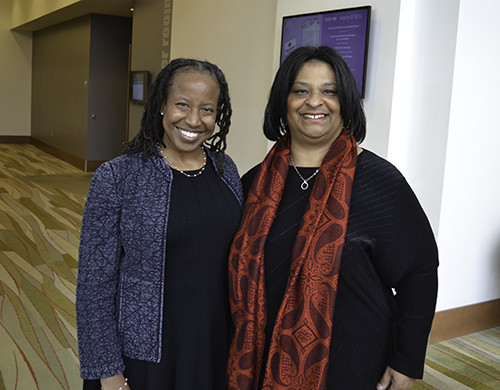 |
| Left to right: Graduate College Associate Dean Assata Zerai and Ave Alvarado, Director of Educational Equity Programs |
COS is actually the brainchild of Ave Alvarado, the Grad College’s Director of Educational Equity Programs, and Zerai is quick to give her credit: “I thank Ave Alvarado, in particular, because she’s the one who spearheaded this and started it many years ago.”
COS was first held at Illinois in 2004. Alvarado claims Debasish Dutta, Dean of the Graduate College, helped institutionalize the program: “I sent him what I had developed for the Community of Scholars, and he thought we should do that again. He thought it was very important that we have such a program.”
However, as the key architect of the COS, Alvarado isn’t tied in to something because that’s how they’ve always done it. She remains flexible about changing aspects of the program in order to best serve the students: “They evolve and change,” says Alvarado, in describing the different activities they’ve provided over the years. “They have to adapt and adjust to the change in the kinds of students we bring in. We do have room always for those changes to take place to make sure that it works for the next group of students.”
So, over the years, COS has featured a variety of components. Early programs featured presentations by community folk to apprise visitors of opportunities for volunteerism or resources. For several years, they brought in big name national speakers, such as African-American economist Julianne Malveaux and Connie Rice, a civil rights activist. However, in recent years, COS has featured big name speakers from Illinois: the keynote speaker for the 2016 COS was Dr. Ronald Bailey, Head of Illinois’ Department of African-American Studies. Most years, the program has included a research symposium and having students visit their perspective research departments.
And as always, inherent in COS is fostering a sense of community. So COS encourages prospective students to meet and network with current Illinois grad students. Alvarado admits:
“It’s still important for our current students and prospective students to connect with each other so that they can get a real understanding of what life would be like for them in graduate school at Illinois.”
How are COS participants selected? Alvarado says the onus is on the departments: “They identify the students that they want to bring to campus. Depending on what the budget looks like at the time, then we try to take as many as we possibly can for this 2-day event. It’s really the department that’s pushing to get students here.”
Regarding its mission to increase the number of underserved students at Illinois, since its inception in the early 1970s, the Educational Equity Programs Office (then called the Office of Minority Affairs) has been charged with providing access to populations who are from racial and ethnic populations who are underrepresented in our undergraduate programs at Illinois: “So the focus has been on racial and ethnic domestic students from those populations," says Alvarado. "The vast majority of the work that we do in the Educational Equity Program Office is with that charge in mind. We’re trying to provide access and inclusion to those underrepresented populations.”
Is COS working? Alvarado believes it is: “We, in our office, can do quite a few things to advance inclusion, but it really is incumbent upon the departments and what they’re able to offer a talented student that is being courted and recruited by any number of other institutions. The student has to weigh what is going to be provided to them if they choose to come to live here.
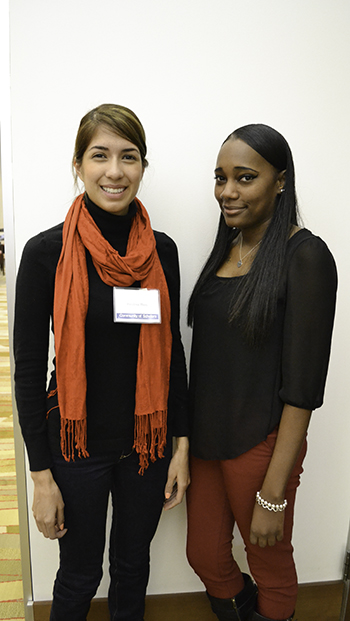 |
| Left to right: Two COS participants who will be attending grad school here in the fall: Kristina Rios, an undergrad from Cal State, Bakersfield, who will be studying Special Education, and Alishia Alexander, who will be studying sociology with a focus on intersects within the minority community. |
Alvarado does caution students considering offers by different institutions to look at more than just the bottom line. Like the cost of living in Champaign-Urbana: “In addition to getting one of the best educations in the world, on top of not having to pay a lot out of pocket to do that, if you compare what it’s like to live in California to what it’s like to live here in Champaign, you are living very well on that same amount of money.”
She also cautions students about hidden costs: “Sometimes you are offered funding but you’re never really clear on what all it is going to have to cover.” She says sometimes a student’s stipend is going to have to go toward paying health insurance.” So sometimes I do talk to students about being very careful of what they are accepting,” she continues. “You can’t get much better than Champaign-Urbana, as far as I’m concerned.”
Alvarado admits that she finds what they’re doing to increase the underserved at Illinois very rewarding. “I’m very proud of the work we’re doing here. The Community of Scholars and several of the other programs that we operate out of our office are programs that I have designed and developed, and the deans have been so wise to say that this is what will work, and this is what we should do.”
How successful has COS been in recruiting students to Illinois? According to Zerai, the numbers speak for themselves: “Last year 86% of the students that participated in Community of Scholars ended up matriculating here, so this is a very successful program.”
An anecdote Alvarado shares underscores the impact COS is having. During a meeting, the diversity officer from another university asked her what the Community of Scholars was. Evidently, a student who had planned on attending their school had changed his/her mind after attending COS, and was coming to Illinois instead.
Despite COS’ stunning 86% success rate, Alvarado quite modestly sums up its impact: “We’ve done quite well in getting students to enroll at Illinois…We give them the full deal about Illinois,” she claims.
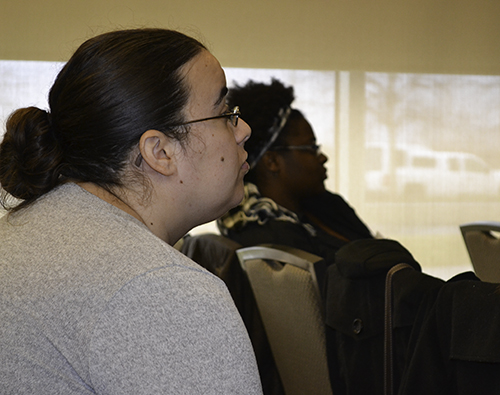 |
| Two COS participants attend a presentation by an Illinois graduate student |
Story and photographs by Elizabeth Innes, Communications Specialist, I-STEM Education Initiative.
For additional I-STEM articles about programs in the Educational Equity Programs Office that target under-represented students, see:
Under-Represented Students Visit Campus, Feel “At Home” at Illinois During ASPIRE
MCB Grad Student Rodriguez-Otero Says SROP Puts a Face to a Grad School Application
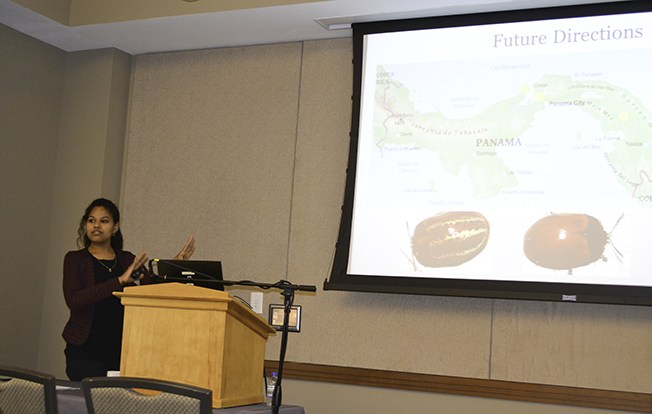 |
| During COS, Lynette Strickland, an Illinois graduate student and member of the WinTG IGERT gives a presentation about her research on different kidns of beetles in Panama. |